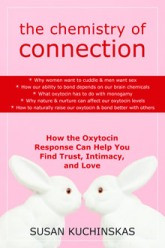In The Chemistry of Connection (New Harbinger Publications, 2009), Berkeley journalist Susan Kuchinskas culls through the last 10 years of brain research to reveal the neurochemical foundations of belonging, love, and intimacy.
Kuchinskas zeroes in on oxytocin–the brain's natural hormone of bonding and trust. With remarkable accuracy, the author distills a great deal of neurochemical complexity to several key concepts about this "cuddle hormone."
- Oxytocin is responsible for our body's "calm and connect" response–the flip-side of our "fight-flight" response to stress.
- Any warm, trusting relationship can boost the amount of oxytocin released into our brain and body.
- A steady release of oxytocin brings with it a wave of contentment which we experience any time we're in the presence of–or even think about–folks with whom we feel closest and most secure. This flood of oxytocin can even change the chemical "script" that underlies habitual patterns in relationships.
Kuchinskas's reporting suggests that by harnessing the brain's inherent neural plasticity–its ability to form new neural connections in response to experience–we can "learn to love at any age." She explores the benefits of oxytocin through the life cycle: from childbirth and parent-child bonding, through adolescence (when gender differences between boys and girls usually take shape) to healthy adult romantic love. She also skillfully distinguishes between the bonding and attachment that oxytocin promote and the sexual or romantic love linked to other brain chemicals.
While more of a fast-track review of the research literature than a self-help book, Kuchinskas's delightfully breezy style makes the findings – and their implications for our happiness–accessible and even fun. Readers come away with a fuller understanding of how to harness their own innate capacities for deep connection and love.
 ©
© 

Comments
Phew… I misread as “oxycontin…”
Seriously, sounds interesting, but I wonder if maybe we’re not going through as much a social as a scientific stage of naming neurotransmitters that are supposed to be the key ingredient to happiness… Serotonin, dopamine… Whatever the nature of an organ that can produce an Adolf Hitler or a Dali Lama, the complete picture sure must be complicated.
Maybe someday we’ll figure out that less of the wealth of nations spent on blowing each other’s brains up and more spent on science research like investigating how our brains work would be a wise choice.
——-
Paul Maurice Martin | 10:18 am, July 18, 2009 | Link